Diving into swimming opens a world of benefits for your body and mind. It’s great for improving heart health, toning muscles, or finding peace from daily stress. Swimming is perfect for everyone, no matter your age or skill level.
Swimming is easy on your joints and works out your whole body. In the water, you feel free and light, moving easily. Plus, the rhythm of swimming can calm your mind, easing anxiety and stress.
Key Takeaways
- Swimming is a versatile activity that combines fitness and relaxation
- It offers a low-impact, full-body workout that engages multiple muscle groups
- The calming nature of swimming can have a positive impact on mental well-being
- Swimming is suitable for individuals of all ages and skill levels
- Regularly engaging in swimming can lead to numerous health benefits
Understanding the Fundamentals of Swimming for Fitness and Relaxation
Swimming is great for both your body and mind. It’s good for beginners and experienced swimmers alike. Knowing the basics is key to getting fit and relaxed.
Basic Swimming Strokes for Beginners
Start with the basics to master swimming. Beginners should learn these strokes:
- Freestyle (front crawl): This stroke is common and efficient. It uses a smooth arm and leg movement.
- Backstroke: This stroke is easy and lets you swim on your back. It’s great for breathing.
- Breaststroke: This stroke is classic and relaxing. It uses both arms and legs in a symmetrical way.
- Butterfly: This stroke is more challenging. It requires both arms and legs to move in sync.
Safety Guidelines and Pool Etiquette
Know the safety rules and pool manners before swimming. Be aware of the pool’s depth and lane rules. Always respect others and know your limits.
Getting Started with Water Confidence
Building confidence in the water is important. Start in shallow areas and use aids like kickboards. With practice, you’ll feel more at ease in the pool.
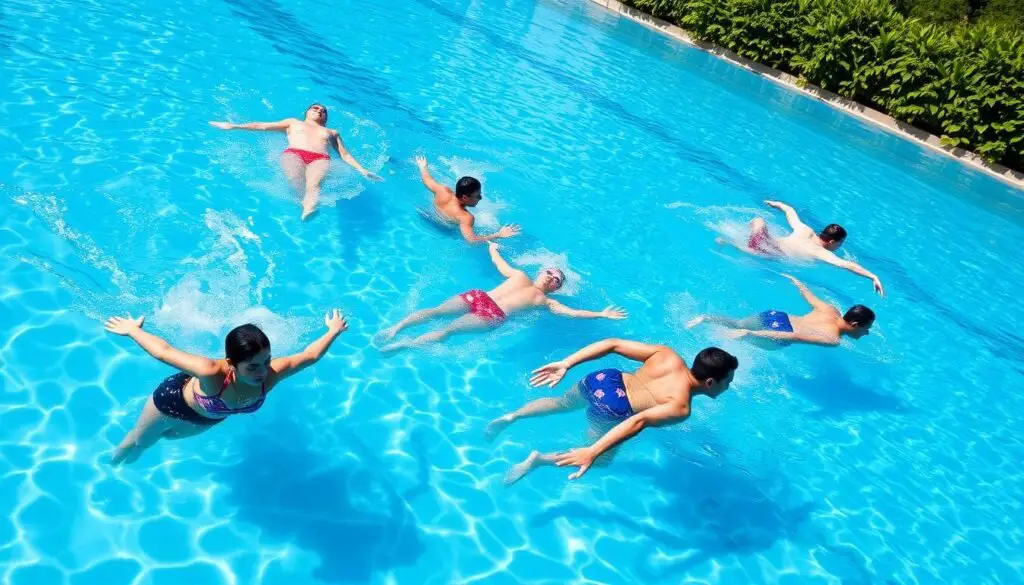
| Swimming Stroke | Muscle Groups Engaged | Calorie Burn (per hour) |
|---|---|---|
| Freestyle | Arms, shoulders, back, abs | 500-700 calories |
| Backstroke | Back, shoulders, abs | 400-600 calories |
| Breaststroke | Chest, shoulders, legs | 550-750 calories |
| Butterfly | Arms, shoulders, back, abs | 600-800 calories |
Health Benefits of Regular Swimming Activities
Swimming is more than just a fun activity. It also brings many health benefits that can make you feel better overall. Whether you want to get fit, lose weight, or just relax, swimming can help a lot.
Swimming is great for your heart and blood flow. It’s a low-impact exercise that strengthens your heart and improves blood circulation. This can lower your risk of heart disease and high blood pressure. Plus, swimming can make your muscles stronger and boost your endurance.
If you have joint problems or injuries, swimming can be a big help. The water’s buoyancy eases the stress on your joints. This makes swimming perfect for people with arthritis or those recovering from injuries. It’s also a great way to lose weight because it burns calories without straining your body too much.
| Health Benefit | Description |
|---|---|
| Improved Cardiovascular Health | Swimming strengthens the heart and improves blood circulation, reducing the risk of heart disease and high blood pressure. |
| Increased Muscle Strength and Endurance | The resistance of the water helps build muscle strength and endurance, leading to overall physical fitness. |
| Enhanced Flexibility | The range of motion required in swimming can improve flexibility and mobility. |
| Weight Loss and Body Toning | Swimming is an effective low-impact exercise that can help you burn calories and tone your body. |
Swimming can change your life if you want to improve your heart health, build muscle, or just relax. So, get in the water and see the many health benefits swimming has to offer.
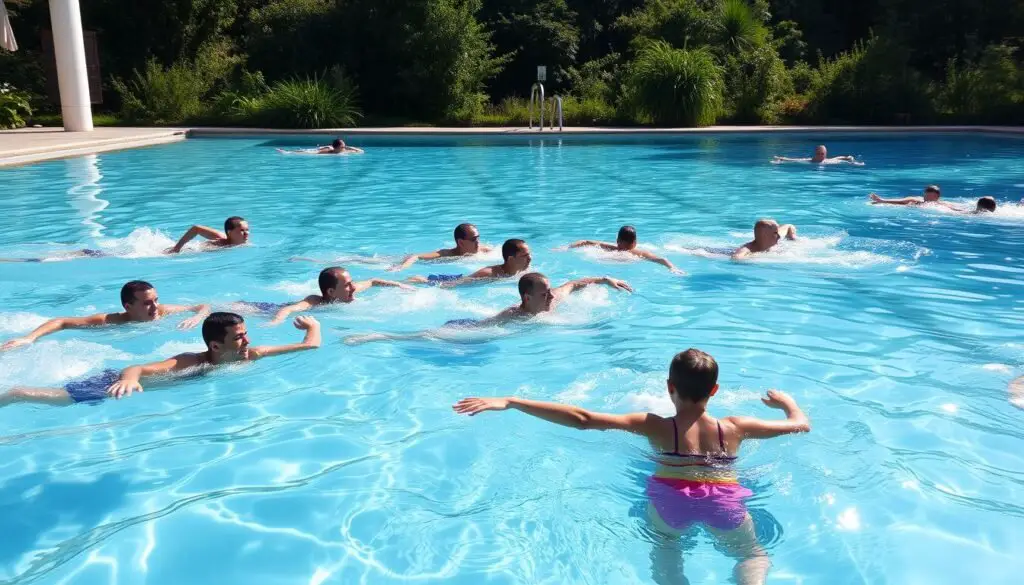
Essential Swimming Gear and Equipment for Success
Having the right swimming gear and accessories can greatly improve your swimming experience. It’s not just about the swimsuit; goggles and training equipment play a big role too. The right gear boosts your comfort, confidence, and efficiency in the water.
Choosing the Right Swimsuit
Your swimsuit should fit well and support your body. It should also help you move smoothly in the water. Think about the fabric, fit, and design to find the best swimsuit for you.
Goggles and Accessories
Good swimming goggles are essential for clear vision and comfort. Look for goggles that seal well, protect from UV rays, and don’t leak water. Swim caps and ear plugs also help by keeping your hair and ears dry.
Training Equipment Options
- Kickboards: Useful for isolating and strengthening your leg muscles during swimming workouts.
- Pull buoys: Help you focus on upper body strength and technique by keeping your legs afloat.
- Swim paddles: Provide additional resistance to build upper body strength and improve stroke mechanics.
- Resistance bands: Allow you to incorporate challenging exercises and drills to enhance your overall fitness.
Investing in the right swimming gear and accessories can elevate your swimming experience. Whether you’re new or experienced, the right equipment makes swimming more comfortable, confident, and effective. This leads to a more enjoyable and productive workout.
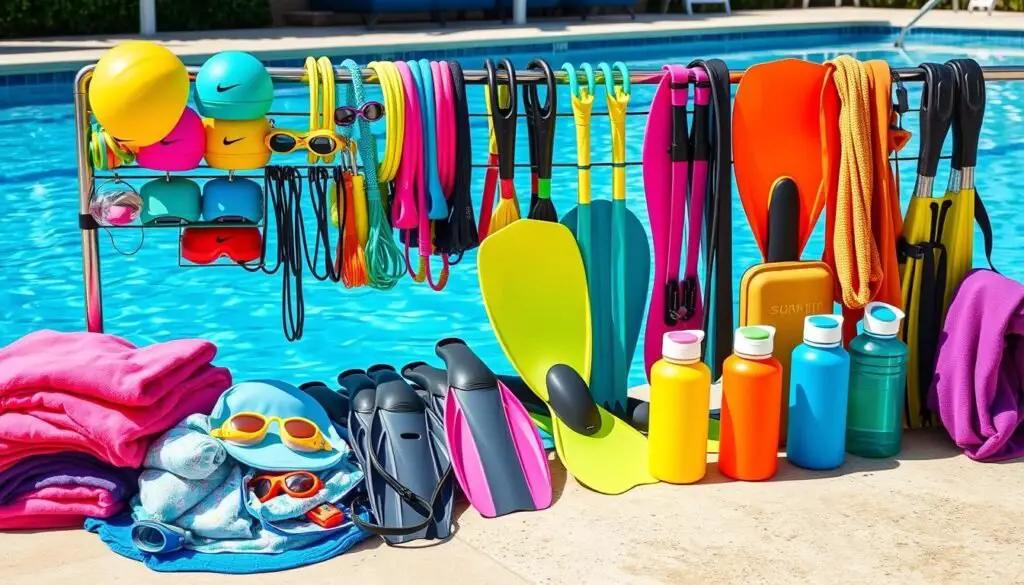
Swimming Techniques for Maximum Efficiency
To swim efficiently, swimmers need to learn advanced swimming techniques and swimming exercises. They should focus on the right body position, breathing, and stroke mechanics. This helps them swim faster and use less energy.
Streamlining and Body Alignment
Keeping your body streamlined is key to swimming faster. Swimmers should aim to be long and straight, with their head down and legs together. This shape cuts down on resistance and boosts speed.
Breathing Techniques
Good breathing is vital for a steady pace and avoiding tiredness. Swimmers should breathe on both sides to keep their stroke balanced and get enough oxygen.
Stroke Refinement
Improving your swimming strokes takes practice. Focus on how your hands enter the water and your kick. This helps you swim more efficiently and move forward better.
| Stroke | Key Technique | Benefits |
|---|---|---|
| Freestyle | Smooth, continuous arm rotation | Efficient forward movement, low resistance |
| Backstroke | Powerful, high-elbow pull | Stable body position, good for spine alignment |
| Breaststroke | Streamlined body position, smooth kick | Low impact on joints, excellent for rehabilitation |
| Butterfly | Synchronized arm and leg motion | Challenging, builds core strength and endurance |
By using these advanced swimming techniques and swimming exercises, swimmers can swim better and faster. They’ll see big improvements in their performance in the water.

Creating an Effective Swimming Workout Routine
Creating a good swimming workout routine is key to getting the most out of swimming. It should include warm-up, interval training, and endurance-building sessions. This way, you can reach your fitness goals and feel refreshed.
Warm-up and Cool-down Exercises
Start with dynamic stretches and light movements to get your muscles ready. This warm-up boosts blood flow, flexibility, and reduces injury risk. Finish with gentle stretches and swimming to ease back into rest, helping your body recover.
Interval Training in the Pool
Interval training is great for swimming. It mixes fast swimming with slower laps. This boosts your heart health, stamina, and swimming skill.
Endurance Building Sessions
Focus on swimming longer distances to improve endurance. These sessions help you swim steadily over longer times. As you get fitter, you can swim further and faster.
| Swimming Workout Components | Benefits |
|---|---|
| Warm-up and Cool-down Exercises | Prepare the body, reduce injury risk, and facilitate recovery |
| Interval Training | Enhance cardiovascular fitness, build stamina, and improve efficiency |
| Endurance Building Sessions | Develop the ability to maintain a consistent pace over longer distances |
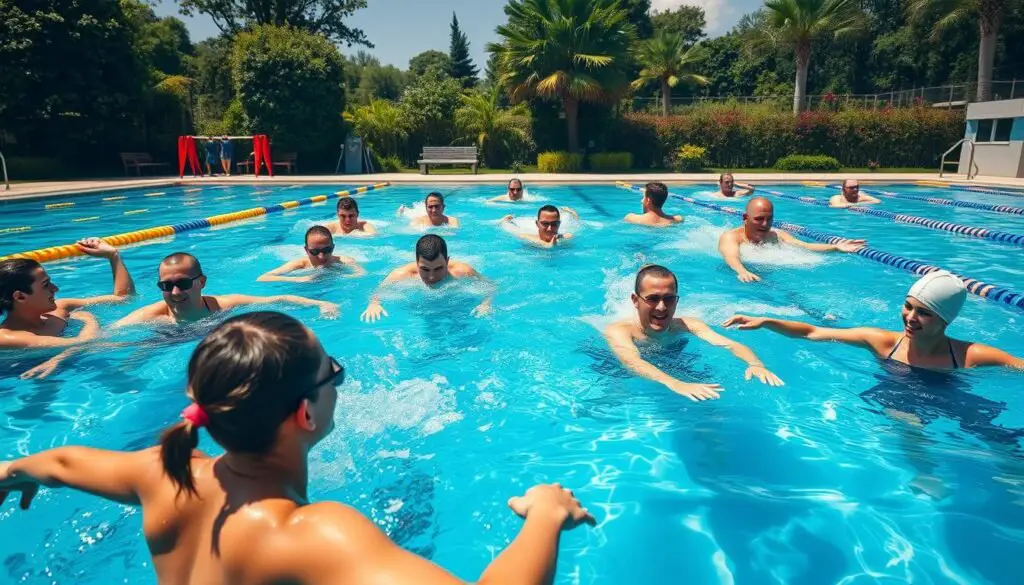
Adding these key parts to your swimming routine unlocks its full benefits. You’ll see better heart health, muscle tone, and overall well-being.
Mental Health Benefits and Stress Relief Through Swimming
Swimming is more than just a workout. It’s a way to boost your mental health and cut down stress. The smooth motion of swimming helps you focus and relax, letting you forget about daily stress.
Swimming does more than just keep you fit. It makes you feel good by releasing happy hormones. Swimming for stress relief can change your life, making you feel calm and ready for anything.
“Swimming has a unique ability to soothe the mind and body. The combination of physical activity and the calming environment of the water can work wonders for mental well-being.” – Dr. Amanda Johnson, Clinical Psychologist
Swimming also lowers blood pressure, helps you sleep better, and boosts your mood and confidence. It’s easy to do, making it perfect for anyone wanting to relax and feel better.

If you’re dealing with anxiety, depression, or just need a break, swimming can help. Its calming effects and focus-enhancing strokes make it a powerful tool for mental health.
Swimming for Weight Loss and Body Toning
Swimming is a great exercise that boosts fitness and helps with weight loss and toning. It works your whole body, burning lots of calories and strengthening muscles.
Calorie Burning Potential
Swimming is excellent for burning calories. You can burn 400 to 700 calories per hour, depending on how hard and long you swim. This makes swimming a top choice for losing weight and reaching fitness goals.
Muscle Engagement During Swimming
Swimming works many muscles at once, like arms, shoulders, back, core, and legs. As you swim, your muscles help move you forward. This improves muscle tone and definition all over your body.
“Swimming is an excellent exercise for weight loss and body toning because it works multiple muscle groups simultaneously, leading to a more efficient and effective workout.”
To get the most out of swimming, mix up your strokes and speeds. You can do fast intervals or easy laps. Swimming’s flexibility lets you adjust your workouts to fit your fitness level and goals.
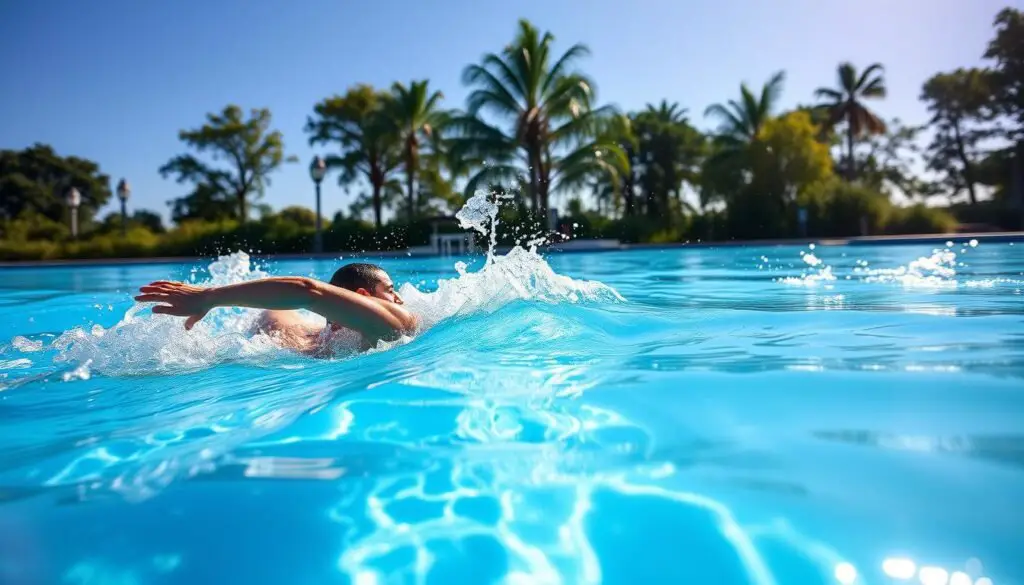
Swimming’s calorie-burning and muscle-toning benefits make it a key part of a balanced fitness plan. It supports weight loss and shaping your body. Whether you’re experienced or new to swimming, adding it to your routine can transform your health and physique.
Aquatic Therapy and Rehabilitation Benefits
Water-based activities, like aquatic therapy, are becoming key in rehab and therapy. Water’s unique qualities, such as buoyancy and resistance, make it perfect for those looking for low-impact exercises. It’s also great for people recovering from injuries or medical conditions.
One big health benefit of swimming and aquatic therapy is how it eases the stress on joints and muscles. Water’s buoyancy lets people do exercises with less strain on their bodies. This is especially good for those with joint pain, arthritis, or recent injuries.
Water also offers resistance that helps build muscle strength and flexibility without the need for high-impact activities. This gentle exercise method is great for people in physical rehab or with chronic conditions like neurological disorders or chronic pain.
The warm water in aquatic therapy also helps relax muscles, reduce spasms, and improve blood flow. This helps a lot in the rehab process.
| Benefits of Aquatic Therapy | Conditions Treated |
|---|---|
|
|
Adding aquatic therapy to their routines can greatly benefit individuals. It helps in recovery, boosts physical and mental health, and improves life quality.
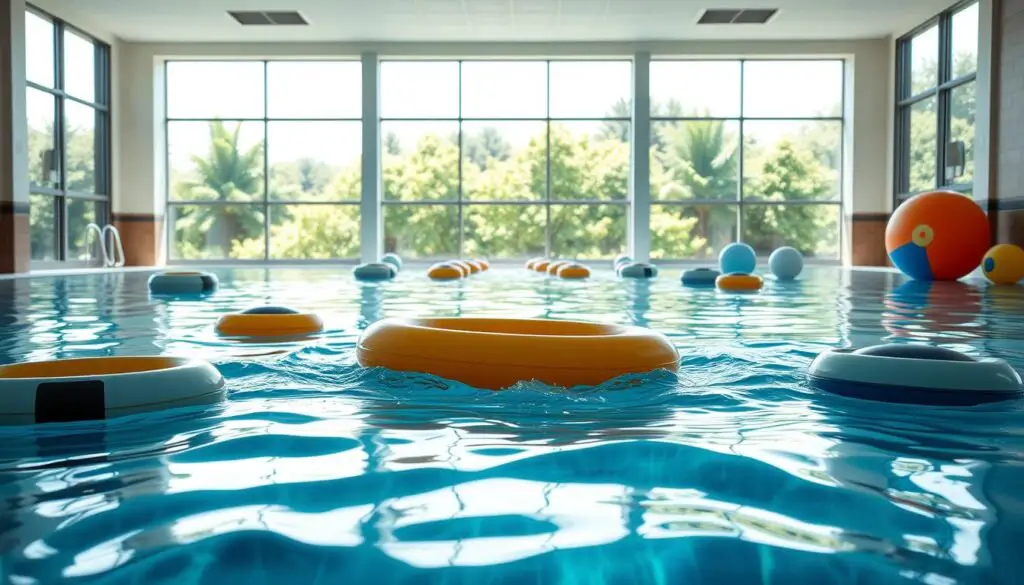
Swimming Pool Maintenance and Water Safety
Keeping a swimming pool clean is more than just occasional cleaning. It’s about making sure everyone has a safe and fun time. This part will cover how to keep your swimming pool in top shape and safe for everyone.
Water Quality Management
Good water quality is key for swimming pool maintenance. You need to check and adjust the pH, chlorine, and other chemicals often. This stops bad bacteria and algae from growing. Also, a working filter system is vital for clear water and removing dirt.
- Regularly test and adjust chemical levels
- Ensure the filtration system is functioning efficiently
- Implement a routine cleaning schedule to prevent buildup
Safety Equipment Requirements
Having the right safety gear is also crucial. This includes life jackets, pool alarms, and clear depth signs. You should also have signs with emergency numbers and pool rules.
- Ensure life jackets and other safety equipment are readily available
- Install pool alarms to detect unauthorized access or emergencies
- Clearly mark pool depths and post safety guidelines for all swimmers
By focusing on water quality and safety, you make your pool a great place for swimming for fitness and relaxation. Good swimming pool maintenance and safety steps are key to keeping your pool and its users healthy and happy.
“A well-maintained pool is the foundation for a safe and enjoyable swimming experience.”
Advanced Swimming Techniques and Training Methods
If you’re an experienced swimmer, you might want to improve your skills. Learning advanced swimming techniques and using special training methods can boost your performance. This section covers elite swimming, including stroke mechanics, underwater swimming, and flip turns.
Perfecting Your Stroke
Good stroke technique is key to efficient swimming. Try different strokes like freestyle, backstroke, breaststroke, and butterfly. Focus on drills for hand entry, body rotation, and kick timing.
Underwater Swimming Prowess
Being good underwater can give you an edge in swimming. Learn underwater kicking and dolphin kicks. Work on keeping your body streamlined and smooth transitions from underwater to surface.
Mastering Flip Turns
Flip turns are crucial for competitive swimmers. Practice efficient entries, smooth rotations, and strong push-offs. Try different turns like open and tucked turns to find what works for you.
Specialized Training Drills
Use various drills to focus on your swimming techniques and swimming workouts. Try single-arm drills, kick-focused sets, and strength exercises. These can improve your swimming.
By mastering these advanced swimming techniques and adding specific swimming workouts to your routine, you’ll reach your swimming potential. Stay committed and enjoy the journey of getting better.
Incorporating Swimming into Your Fitness Lifestyle
Swimming is a great exercise that fits well into a fitness routine. It can be mixed with other activities to improve health and wellness. This way, you get the most out of your workouts and live a balanced life.
Balancing Swimming with Other Exercises
Swimming is great for your heart, but it’s good to mix it with other exercises. This helps work out different muscles and keeps your fitness routine well-rounded. Here are some activities to add to your routine:
- Strength training exercises, such as weightlifting or resistance training, to build muscle and improve overall body composition.
- High-intensity interval training (HIIT) workouts to boost your metabolism and increase calorie burn.
- Low-impact activities like yoga or Pilates to improve flexibility, balance, and mindfulness.
Setting Realistic Swimming Goals
Setting realistic swimming goals is key to staying motivated and successful. Here are some tips for setting your goals:
- Start with achievable, short-term goals, such as increasing your lap count or improving your stroke technique.
- Gradually work your way up to more challenging, long-term goals, such as completing a specific distance or participating in a local swimming event.
- Regularly review and adjust your goals as you progress to keep yourself challenged and engaged.
By mixing swimming with other exercises and setting realistic goals, you can make a fitness lifestyle. This lifestyle includes the benefits of swimming for fitness and relaxation and fits well with your overall wellness routine.
Common Swimming Mistakes and How to Avoid Them
Swimming is a great way to stay fit, but even experienced swimmers can make mistakes. These mistakes can slow down progress and make swimming less fun. By knowing these common errors, swimmers can improve their techniques and enjoy their workouts more.
One big mistake is bad breathing. Many swimmers breathe too little or too hard, which tires them out. To fix this, take regular, calm breaths. Breathe out slowly and fully when your face is underwater.
- Inhale through your mouth as your head is above the water
- Exhale slowly and steadily through your mouth or nose while your face is submerged
- Practice this breathing pattern until it becomes second nature
Another mistake is using the wrong stroke mechanics. Swimmers might move their arms or legs too much, wasting energy. To fix this, aim for a smooth, streamlined stroke with less splashing.
- Focus on your hand entry and body alignment to reduce drag
- Refine your kicking technique, ensuring it is consistent and balanced
- Work on your timing and coordination between your arms and legs
Keeping your body in the right position is key to swimming well. Swimmers who don’t stay horizontal struggle with speed and staying in the water. To get better at body positioning:
- Keep your head in line with your spine, avoiding excessive lifting or dropping
- Engage your core muscles to maintain a stable, balanced position in the water
- Experiment with adjusting your body position to find the most efficient and comfortable posture
By fixing these common mistakes and using the right techniques, swimmers can improve their swimming techniques and swimming exercises. This makes swimming more fun and rewarding.
Conclusion
Swimming is more than just a hobby; it’s a way to improve your health. It boosts your heart health and helps your mind relax. Swimming can change your life for the better.
We’ve talked about the basics of swimming, like how to swim and stay safe. We’ve also looked at how swimming can help you lose weight and feel less stressed. It’s a great way to get fit and feel good.
Swimming is for everyone, whether you’re already good at it or just starting. The tips and benefits we’ve shared can help you make swimming a big part of your life. So, get in the water and see how swimming can make you healthier and happier.
FAQ
What are the health benefits of swimming?
Swimming is great for your heart, muscles, and flexibility. It can also help you lose weight. Plus, it’s easy on your joints, making it perfect for those with injuries or joint problems.
How do I get started with swimming for fitness and relaxation?
First, build your confidence in the water. Learn basic strokes like freestyle and backstroke. Know the safety rules and pool manners. Start with short swims and gradually do more as you get better.
What type of swimming gear and equipment do I need?
You’ll need a good swimsuit, goggles, and maybe a swimming cap. For more challenging workouts, consider kickboards, pull buoys, and resistance bands.
How can swimming help with stress relief and mental health?
Swimming’s rhythm can help you focus and calm down. It releases happy hormones that boost your mood. It’s a great way to relax and forget about daily worries.
Is swimming effective for weight loss and body toning?
Yes, swimming is great for losing weight and toning your body. It works out your whole body, burning calories and building muscle. How many calories you burn depends on how hard and long you swim.
How can I incorporate swimming into my overall fitness routine?
Mix swimming with other exercises like strength training and cardio. Set swimming goals, like getting better at swimming or enjoying it more. Swim more often and for longer to see better results.
What are some common swimming mistakes and how can I avoid them?
Mistakes include bad breathing, stroke, and body position. To avoid these, practice proper techniques, swim often, and get help from a coach if needed.

One Reply to “Swimming for Fitness & Relaxation | Health Benefits”